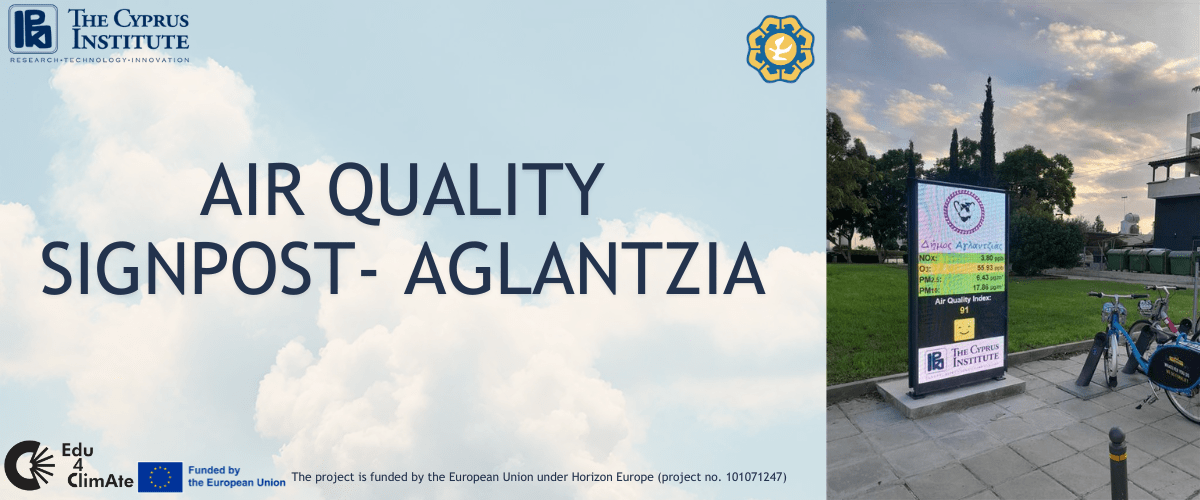Aglantzia Air Quality signpost

Frequently asked questions
For each measurement, the colors green, yellow, and red are used, in accordance with the air pollution levels specified by the Labor Inspection Department and based on the limits set by the European Union.
- If the indicator is green, it means that the percentage of that pollutant in the atmosphere is below the limits set by the European Union.
- If the indicator is yellow, it means that the percentage of that pollutant in the atmosphere is above the permissible limits set by the European Union.
- If the indicator is red, this means that the percentage of this pollutant in the atmosphere is double the permissible limits set by the European Union.
|
Pollutant |
Low (1) |
Moderate (2) |
High (3) |
Very high (4) |
|
NOx |
0 – 100 |
100 – 150 |
150 – 200 |
> 200 |
|
O3 |
0 – 100 |
100 – 140 |
140 – 180 |
> 180 |
|
PM2.5 |
0 – 25 |
25 – 50 |
50 – 100 |
> 100 |
|
PM10 |
0 – 50 |
50 – 100 |
100 – 200 |
> 200 |
| Air Pollution level | Health Impacts [*] |
| Low(1) |
Negligible to low health effects, low health risk; negligible percentage of symptoms appear even for the sensitive parts of the population [**]. |
| Medium(2) |
Moderate health risk: There is a chance of mild health effects and related symptoms for sensitive parts of the population [**] and especially for those having respiratory problems (asthma etc). Such persons should consider to reduce strenuous physical activities, especially outdoors. |
| High(3) |
Health risk may occur: Sensitive parts of the population may demonstrate adverse health effects and related symptoms [**]. Those having respiratory problems (asthma, etc) as well as those suffering from cardiovascular and respiratory diseases should avoid outdoors/physical activity and should stay away from high air pollution as well as high air temperature areas. Such persons may possibly be in need for medical advice or even help especially if they demonstrate symptoms. People with asthma may need to use their reliever inhaler more often. Older people should also reduce physical exertion. |
| Very High(4) |
High health risk for sensitive parts of the population [**]: Those suffering from respiratory problems (asthma, allergies etc) as well as those suffering from cardiovascular or respiratory diseases should move away from high air pollution as well as high air temperature areas, and should avoid any activity that may worsen their condition. Older people, should avoid strenuous physical activity. Such persons are very likely to be in need for medical help and advice. Some healthy individuals may demonstrate irritation and discomfort symptoms. |
[*] Health impacts listed in this table are of general nature and refer to the overall population. The content of this web site does not replace any medical advice, which should be taken into account by all those likely to develop any type of symptom. For those individuals that are in a health status which may worsen or may even become health threatening, it is necessary to seek medical advice and guidelines in advance of any air pollution event, and to be in direct contact with their medical doctor.
[**] The term sensitive parts of the population usually refer to the elderly, children, and patients (cardiovascular and respiratory problems). Individuals belonging to this group should follow the advice of their medical doctor concerning their everyday activities. As there is always a possibility of symptom development for very sensitive individuals, proper precaution measures should be taken even under low air pollution levels.
Live View
About the Edu4Climate program
Edu4Climate aims to strengthen higher education networks in Cyprus and Greece and enhance their cooperation with European institutions and national and European research and innovation ecosystems in order to tackle climate change and air pollution in the Eastern Mediterranean and Middle East (EMME) region. The EMME region, which geographically includes Cyprus and Greece, has been identified as the region most vulnerable to the climate crisis. Therefore, regional climate actions in the EMME are of strategic importance for the success of European and global climate efforts to achieve the goals of the Paris Agreement.
The Edu4Climate consortium received €2 million in funding from the European Commission’s Horizon Europe Coordination & Support Action (CSA) “European Excellence Initiative” (EEI) program (under grant agreement No. 101071247).